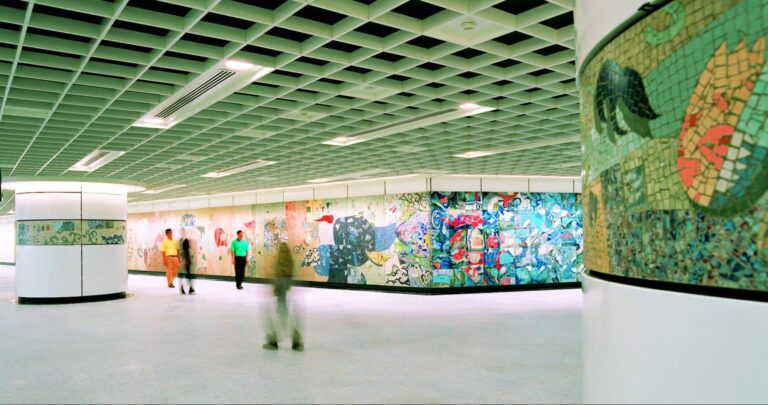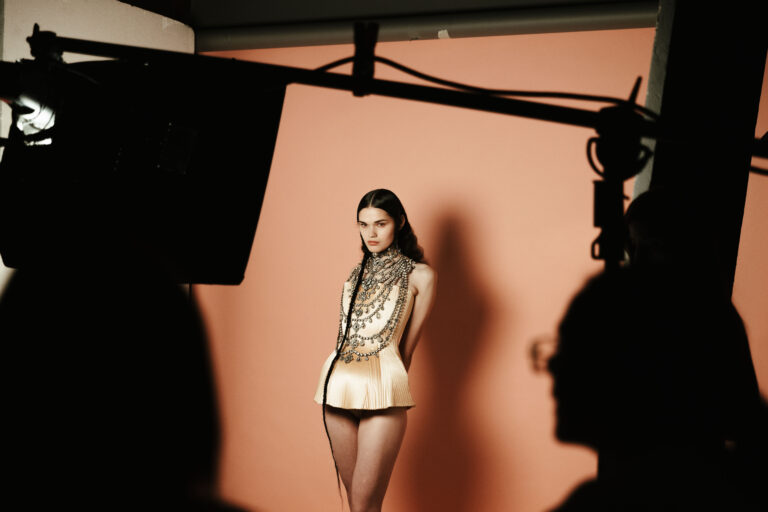
On the opening day of this year’s Singapore International Festival of Arts (SIFA), I was part of the Friday peak hour commute that poured out from the Bedok train station onto the street. Finding my way to the large open space between Bedok Mall and the food centre, I walked up to the Pavilion, which was covered in the blue of the sea. I wedged myself into a crowd of enthusiastic bystanders, where I struggled to make myself heard over a resident demanding to know what time the show was going to start. Deep inside the Pavilion, a stone’s throw away from one of Bedok Food Centre’s famous Hokkien mee stalls, came strains of an orchestra warming up.

It was early, so I wandered off to one of the Pavilion’s less busy corners. An activation space had been set up. This week it was an A-frame shaped like a hut atop a wooden platform, both festooned with large palm leaves as tall as a person. A man of around seventy was standing at the frame, weaving, taking the up the thin, individual leaflets and braiding them under and over other fronds. Who was he? I asked a volunteer. She shrugged. Someone from the neighbourhood.
I sat down on one of the low stools and started weaving too. At some point, the artist Quek See Yee crawled in next to me. See Yee oriented me to the textual vignettes of Bedok printed on a nearby board. Her work, Hearsay, was a tribute to the stories told about Bedok — morsels of oral history about landmarks, the fishing village by the sea, old street names. Weaving was her representation of how stories of Bedok travel. All this time during our chat, my hands never stopped; I continued to weave. Quek’s Hearsay had taken me captive, but I was not the only one. When I pulled myself away to take my seat for the upcoming performance, I saw from the corner of my eye that the man was still at it.

The SIFA Pavilion, on view till 1 June 2025, is anchored by an orange, layered, amoeba-like structure — an installation designed by local artist Wang Ruobing. Titled Beneath Tide, Running Water, the work consists of a performance stage that boldly displays its workings: you can see, under the wooden slabs, mechanical systems attached to clumps of rushes, and, more importantly, plastic debris. Looking at these mechanical parts, you realise that these objects can move. And it is their movement that brings alive this stage, a giant coral reef. This is a reef that is orange and therefore a healthy one — not bleached bone-white from climate change and other environmental stressors — but also one pulsating with the worst and the most realistic of Southeast Asian marine debris: disposable water bottles.
Coming alive twice during the festival’s opening performance The Sea and the Neighbourhood, the bobbing bottles made a disturbing, dystopic, and ominous backdrop to the graceful wave-like formations of dancers from the Singapore Ballet, taking the stage to choreography by Christina Chan. It is “beautiful but ironic,” says Ruobing of these irreconcilable scenes.

On big screens in two corners of the Pavilion, Brian Gothong Tan’s work Speculative F(r)ictions adds another dimension to unsettling the story of the east. The ten-minute long video, like Beneath Tide, Running Water and Hearsay, also responds to Bedok and its environs. Tan has used AI to weave together a number of inspirations. The origin tale represented by Tok Lasam, alleged founder and penghulu (headman) of ancient Siglap, finally crowned, yet never escaping his shifting identities. Faceless colonial soldiers, referencing the Bedok coast as the site of World War II massacres. The present, installing pan-Asian faces amidst Angkor- and Hindu-style ruins, morphs into our lives in a giant greenhouse. And the future? The resulting work, Tan says, is also from pushing the AI’s potential to hallucinate — an invisible, non-human hand.
It remains to be seen how Bedok residents respond to these stories, and what else these cultural and environmental fictions might trigger. But, fundamentally, the SIFA organisers have built a space that invites people to come together. Based on the clamour and the curiosity of opening night, and the energetic high-concept performance that electrified Bedok Central for one dazzling hour, it is already succeeding.
Before I departed, I looked over my shoulder. The man was still there, with the palm fronds, weaving.
___________________________________
The SIFA Pavilion is accessible for the duration of the festival, which runs till 1 June 2025. Further activations, workshops, and performances will take place from 23–25 May and 30 May – 1 June. Find out more at sifa.sg.
Read our other SIFA 2025 story, “A Thousand Stitches with Kaylene Tan,” here.
Support our work on Patreon
Become a memberYou might also like
Resurrecting Our Past Selves: Likenesses at the Goethe-Institut New York

Start Looking at the Floors and Around You: Sights and Sound Bites from Art Outreach’s Art in Transit Tour

When Couture Gets Crafty: UBS House of Craft x Dior Arrives in Singapore

